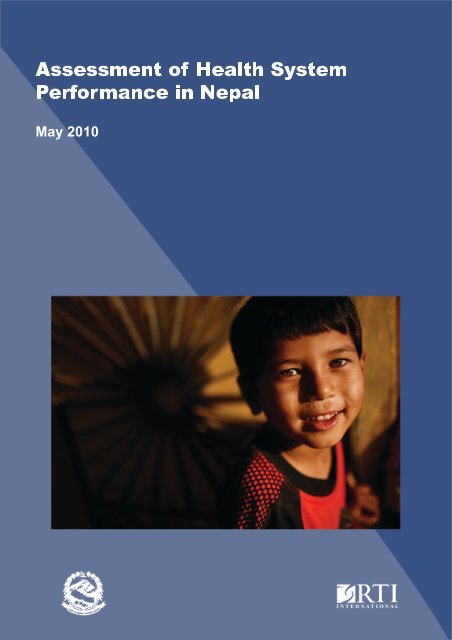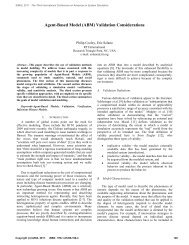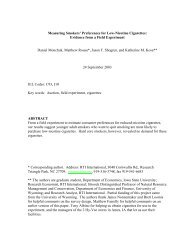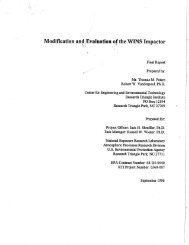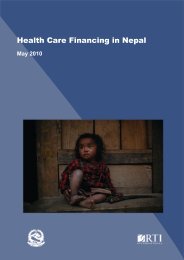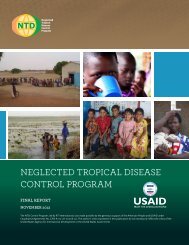Assessment of Health System Performance in Nepal - Ministerial ...
Assessment of Health System Performance in Nepal - Ministerial ...
Assessment of Health System Performance in Nepal - Ministerial ...
Create successful ePaper yourself
Turn your PDF publications into a flip-book with our unique Google optimized e-Paper software.
<strong>Health</strong> <strong>System</strong> <strong>Performance</strong> 2010Key Po<strong>in</strong>ts• <strong>Health</strong> is both a direct component <strong>of</strong> human well-be<strong>in</strong>g and a form <strong>of</strong> human capitalthat <strong>in</strong>creases an <strong>in</strong>dividual’s capabilities. Better health significantly contributes toeconomic development and to the reduction <strong>of</strong> poverty and <strong>in</strong>come <strong>in</strong>equality• <strong>Nepal</strong> has made significant progress <strong>in</strong> the health sector over the past decade. <strong>Health</strong><strong>in</strong>dicators such as life expectancy, <strong>in</strong>fant/child mortality, and maternal mortality showgradual but steady improvement• Despite these achievements, there are still large <strong>in</strong>equalities <strong>in</strong> health outputs andhealth outcomes across geographic regions and socioeconomic groups• Increas<strong>in</strong>g the real per capita <strong>in</strong>come by 10 percent, will cause the IMR to fall by 7percent, child mortality rate (CMR) by 11 percent, and life expectancy rate (LER) will<strong>in</strong>crease by almost 2 percent. Increas<strong>in</strong>g the ratio <strong>of</strong> health budget to total budget by10 percent, CMR will decrease by 4.5 percent, and LER will <strong>in</strong>crease by 0.6 percent.If we provide more services by <strong>in</strong>creas<strong>in</strong>g health services, for example <strong>in</strong>creas<strong>in</strong>gnumber <strong>of</strong> beds by 10 percent, IMR will fall by 4 percent and LER <strong>in</strong>crease by 1percent.• The results show that <strong>in</strong> recent years, public health <strong>in</strong>stitutions have less capacity toimprove <strong>in</strong>termediate health outputs because <strong>of</strong> a shortage <strong>of</strong> human resources,number <strong>of</strong> health <strong>in</strong>stitutions, and <strong>in</strong>stitution-related <strong>in</strong>puts• Equity and efficiency are not <strong>in</strong> conflict. Improvement <strong>of</strong> <strong>in</strong>stitutional capacity <strong>in</strong> thedelivery <strong>of</strong> health services (at least <strong>in</strong>creas<strong>in</strong>g the numbers <strong>of</strong> <strong>in</strong>stitutions andmanpower <strong>in</strong> the <strong>in</strong>stitutions) can shift the health production function ensur<strong>in</strong>g equity<strong>in</strong> health care services across regions. Allocation <strong>of</strong> resources accord<strong>in</strong>g to needs canimprove equity and efficiency <strong>of</strong> health outputs; however, a blanket policy will nothave such a capacity• Private providers play a complementary role <strong>in</strong> provid<strong>in</strong>g health services andcontribut<strong>in</strong>g to improvement <strong>of</strong> health outcomes. Thus, this report <strong>in</strong>cludes not onlypublic providers, but also how to make better use <strong>of</strong> private capacity to improvehealth outcomes• Money matters to the health care system, but it does not guarantee efficient, equitable,and effective health care services. <strong>Health</strong> care f<strong>in</strong>anc<strong>in</strong>g has the power to reformhealth care delivery and provide <strong>in</strong>centives to providers to deliver efficient andeffective health careiii
Eligibility criteria for becom<strong>in</strong>g a DMP (checklist A)The DMP must be a registered medical practitioner who: has normally had at least three years recent cl<strong>in</strong>ical experience with a group <strong>of</strong>patients/clients <strong>in</strong> the relevant field <strong>of</strong> practice is <strong>in</strong> a GP practice and is either vocationally tra<strong>in</strong>ed or has a certificate <strong>of</strong>equivalent experience from the Jo<strong>in</strong>t Committee for Postgraduate Tra<strong>in</strong><strong>in</strong>g <strong>in</strong>General Practice Certificate or is a specialist registrar, cl<strong>in</strong>ical assistant or aconsultant with<strong>in</strong> a NHS Trust or other NHS employer has the support <strong>of</strong> the employ<strong>in</strong>g organisation or GP practice to act as a DMP whowill provide supervision and support to the NMP student and opportunities todevelop competence <strong>in</strong> prescrib<strong>in</strong>g practice has some experience or tra<strong>in</strong><strong>in</strong>g <strong>in</strong> teach<strong>in</strong>g and/or supervis<strong>in</strong>g <strong>in</strong> practice normally works with the tra<strong>in</strong>ee prescriber. If this is not possible (such as <strong>in</strong> nurseledservices or community pharmacy), arrangements can be agreed for anotherdoctor to take on the role <strong>of</strong> the DMP, provided the above criteria are met and thelearn<strong>in</strong>g <strong>in</strong> practice relates to the cl<strong>in</strong>ical area <strong>in</strong> which the tra<strong>in</strong>ee prescriber willultimately be work<strong>in</strong>gCharacteristics <strong>of</strong> a competent DMP (checklist B) 1Teach<strong>in</strong>g Knowledge about teach<strong>in</strong>g methods (how and when to use them)knowledgeTeach<strong>in</strong>g Us<strong>in</strong>g teach<strong>in</strong>g knowledge, giv<strong>in</strong>g feedback, be<strong>in</strong>g able to observe,skills analys<strong>in</strong>g, teach<strong>in</strong>g the tra<strong>in</strong>ee to carry responsibility, encourag<strong>in</strong>greflection, structur<strong>in</strong>g, be<strong>in</strong>g able to teach (pr<strong>of</strong>essional) skills, be<strong>in</strong>gable to handle conflict, be<strong>in</strong>g able to communicate (<strong>in</strong>clud<strong>in</strong>g listen<strong>in</strong>g),phas<strong>in</strong>g <strong>of</strong> tra<strong>in</strong><strong>in</strong>gTeach<strong>in</strong>gattitudePersonalitytraitsGiv<strong>in</strong>g the tra<strong>in</strong>ee latitude, giv<strong>in</strong>g the tra<strong>in</strong>ee respect, be<strong>in</strong>g open tocriticism, be<strong>in</strong>g open to criticism on his/her teach<strong>in</strong>g, be<strong>in</strong>g <strong>in</strong>terested <strong>in</strong>the tra<strong>in</strong>ee, be<strong>in</strong>g able to separate private life and teach<strong>in</strong>g, be<strong>in</strong>g ableto separate the different roles <strong>in</strong> the teach<strong>in</strong>g-relationship (teacher,colleague), be<strong>in</strong>g able to cope with tension result<strong>in</strong>g from be<strong>in</strong>g both aDMP and an NMP tra<strong>in</strong>er, be<strong>in</strong>g a role model, <strong>of</strong>fer<strong>in</strong>g a safeenvironment, <strong>in</strong>dividualis<strong>in</strong>g tra<strong>in</strong><strong>in</strong>g, be<strong>in</strong>g alert, be<strong>in</strong>g critical <strong>of</strong> thetra<strong>in</strong>ee and their learn<strong>in</strong>g process, be<strong>in</strong>g open to extra tra<strong>in</strong><strong>in</strong>g tobecome a better teacher, enjoy<strong>in</strong>g the role <strong>of</strong> teacher, be<strong>in</strong>g availableand reachable, mak<strong>in</strong>g time for teach<strong>in</strong>g, be<strong>in</strong>g able to see th<strong>in</strong>gs <strong>in</strong>perspective, be<strong>in</strong>g stimulat<strong>in</strong>g, not pr<strong>of</strong>it<strong>in</strong>g from the tra<strong>in</strong>ee, be<strong>in</strong>g loyalto the department, will<strong>in</strong>g to share patients with the tra<strong>in</strong>ee, dar<strong>in</strong>g togive feedback, learn<strong>in</strong>g from the tra<strong>in</strong>eeEnthusiasm, flexibility, self-knowledge, ability to reflect, self-<strong>in</strong>sight,patience, <strong>in</strong>tegrity, enjoy<strong>in</strong>g their role as a DMP1 Adapted from: Boendermarker PM, Schul<strong>in</strong>g J, Meybroom-de Jong B, Zwierstra RP, Metz JCM (2000) What arethe characteristics <strong>of</strong> the competent general practitioner tra<strong>in</strong>er? Family Practice, 17(6), 547-5538
<strong>Health</strong> <strong>System</strong> <strong>Performance</strong> 2010To develop an effective mechanism for resource allocation and utilization <strong>in</strong> the health sector,an analysis <strong>of</strong> the equity, efficiency, and effectiveness <strong>of</strong> resource allocation and utilization <strong>in</strong>the health sector is crucial. Simply stated, equity is the notion that greater resources and moreservices should be made available to the most vulnerable and needy groups; efficiency looksat the cost <strong>of</strong> <strong>in</strong>puts for each unit <strong>of</strong> output produced, and effectiveness is the extent to whichactual performance compares with expected performance. A better health system advancesboth efficiency and equity. This analysis <strong>of</strong> the health system seeks to improves performanceby provid<strong>in</strong>g a better understand<strong>in</strong>g <strong>of</strong> the health system to aid <strong>in</strong> the design <strong>of</strong> an evidencebasedpolicy.II. Efficiency analysisEfficiency is concerned with maximis<strong>in</strong>g health outcomes/outputs. As such, there are threetypes <strong>of</strong> efficiency: technical efficiency, cost effectiveness efficiency, and allocativeefficiency, as stated <strong>in</strong> the conceptual framework.2.1 Technical EfficiencyThe follow<strong>in</strong>g is an analysis <strong>of</strong> the causal relationship between <strong>in</strong>puts and outputs <strong>in</strong> thehealth sector. In the health sector, <strong>in</strong>puts are both public and private expenditures, althoughpublic expenditure is the primary factor <strong>in</strong> determ<strong>in</strong><strong>in</strong>g health outcomes and shap<strong>in</strong>g thehealth system <strong>in</strong> develop<strong>in</strong>g countries. Based on the available data, the <strong>in</strong>put-output matrix,on the follow<strong>in</strong>g page, shows the relationship between <strong>in</strong>puts - particularly expenditure <strong>in</strong> thehealth sector - and health outcomes for the last two decades (fiscal years 1989/90 to 2007/08).3
<strong>Health</strong> <strong>System</strong> <strong>Performance</strong> 2010Table 2.1 Input outcome matrixInputFiscal YearPublic Expenditure on <strong>Health</strong>GDP per As % <strong>of</strong> As % <strong>of</strong>capita total GDP1995/96 Budget (HBGDPprice (RPI) (HBTG) )InfantmortalityRate(IMR)ChildMortalityRate(CMR)OutcomeCrudeBirthRate(CBR)LifeExpectancyRate (LER)1989/90 7895.35 4.60 0.93 128.00 197.00 41.60 53.501990/91 8222.13 3.84 0.88 107.00 197.00 39.60 54.001991/92 .8420.13 3.62 0.84 107.00 197.00 39.60 54.001992/93 8472.81 3.40 0.64 102.00 165.00 39.60 54.021993/94 8912.08 4.85 1.08 102.00 165.00 39.60 54.001994/95 8986.90 4.91 1.21 102.00 165.00 37.50 54.001995/96 9271.18 5.99 1.44 102.00 165.00 37.50 54.001996/97 9485.47 6.19 1.42 79.00 118.00 37.80 54.501997/98 9586.51 5.70 1.37 74.70 118.00 35.40 56.101998/99 9747.10 5.69 1.34 69.42 111.72 34.54 57.521999/00 10148.44 6.09 0.80 66.78 108.78 34.10 58.252000/01 13809.56 5.19 0.87 64.14 105.44 33.58 58.952001/02 13527.88 4.91 0.79 64.00 91.00 33.50 60.002002/03 13750.91 5.05 0.81 60.00 83.50 48.00 60.002003/04 14096.31 5.26 0.87 56.00 76.00 46.73 60.982004/05 14304.13 6.00 0.98 52.00 68.50 45.45 62.002005/06 14513.40 6.34 1.13 48.00 61.00 28.40 63.692006/07 14721.22 6.81 1.36 48.00 61.00 28.40 63.692007/08 15219.41 6.63 0.52 48.00 61.00 28.40 63.69Sources: Adhikari and Maskay (2004), MOHP et al, (2009), RTI, (2009)This matrix shows that health outcomes are <strong>in</strong>creased as health <strong>in</strong>puts are <strong>in</strong>creased. All<strong>in</strong>puts are shown <strong>in</strong> monetary terms. These physical <strong>in</strong>puts are measured by the ratio betweenthe population and physical <strong>in</strong>puts. Extension <strong>of</strong> services (health service providers) <strong>in</strong> terms<strong>of</strong> population per service (hospitals, health centres, health posts, ayurvedic service centres,sub-health posts, and primary health centres [SP]), the population per hospital bed (BP) andpopulation per supply <strong>of</strong> skilled manpower (SMP) are also used <strong>in</strong> this analysis.All <strong>in</strong>puts are <strong>in</strong>dependent variables that determ<strong>in</strong>e the level <strong>of</strong> health outcomes (dependentvariables). The correlation coefficients between the dependent and <strong>in</strong>dependent variablesshow the relationships <strong>in</strong> the <strong>in</strong>put-output model.4
<strong>Health</strong> <strong>System</strong> <strong>Performance</strong> 2010Table 2.2: Correlation coefficients <strong>of</strong> the given variablesIMR 1IMR CMR CBR LER RPI HBTG HBGDP SP BP SMPCMR 0.98** 1CBR 0.32 0.29 1LER -0.93** -0.93** -0.34 1RPI -0.90** -0.91** -0.23 0.96** 1HBTG -0.70** -0.74** -0.48* 0.64** 0.58* 1HBGDP 0.06 0.03 -0.16 -0.20 -0.23 0.41 1SP 0.73** 0.75** 0.26 -0.52* -0.55* -0.71** -0.31 1BP 0.18 0.16 0.14 -0.40 -0.28 0.11 0.53* -0.39 1SMP 0.90** 0.88** 0.24 -0.76** -0.73** -0.61** 0.03 0.65** 0.16 1** Significant at 1% level * Significant at 5 % levelIMR has positive correlations with CMR, SP and SMP and negative correlations with LER,RPI, and HBTG at a 1 percent level <strong>of</strong> significance. Similarly, CMR has positive correlationswith SP and SMP, and negative correlation with LER, RPI, and HBTG at a 1 percent level <strong>of</strong>significance. CBR is negatively correlated with only HBTG at a 5 percent level <strong>of</strong>significance. LER has a positive correlation with RPI, HBTG, SP and SMP. The coefficientsthat are significant at 1 percent or 5 percent have theoretically expected signs. The resultssuggest that there are expected relationships between the given variables.2.2 Regression analysisThe most popular method for estimat<strong>in</strong>g the causal relationships between health <strong>in</strong>puts andhealth outcomes was suggested by Filmer and Pritchett (1999), and Adhikari and Maskay(2004), and is used <strong>in</strong> this analysis. The follow<strong>in</strong>g conceptual equation for the “healthproduction function” is:This equation relates the dependent variable, “M”, which is taken to be either that <strong>of</strong> childmorality rate, <strong>in</strong>fant mortality rate, crude birth rate and life expectancy rate, to the log <strong>of</strong>mean per capita <strong>in</strong>come, the log <strong>of</strong> the share <strong>of</strong> public health as a fraction <strong>of</strong> total governmentbudget and the log <strong>of</strong> the share <strong>of</strong> public health as a fraction <strong>of</strong> GDP. “X” is the <strong>in</strong>dependentvariable which control for a variety <strong>of</strong> other socio-economic factors. Regression analysishelps illustrate the causal relationships between <strong>in</strong>put and outcome variables.5
<strong>Health</strong> <strong>System</strong> <strong>Performance</strong> 2010Table 2.3: Regression analysis and <strong>in</strong>terpretationsDependentvariableReal GDPper capitaRatio <strong>of</strong> healthbudget to totalgovernmentbudgetRatio <strong>of</strong>healthbudget toGDPNumber <strong>of</strong>peopleserved bythe healthcareprovidersNumber <strong>of</strong>peopleserved bya bedNumber <strong>of</strong>peopleserved byskilledmanpowerIMR -0.7180 -0.1850 -0.0093 0.1099 0.4132 0.2222Interpretations(overall modelsignificant at 1%level with highSquared (0.9684)Significantat 1% withexpectedsignExpected signbut notsignificantExpectedsign butnotsignificantExpectedsign but notsignificantExpectedsign andSignificantat 10%Expectedsign andSignificant at5%CBR 0.1085 -0.4653 0.0470 0.1083 0.4914 -0.0873Interpretations(overall modelnot significant)notsignificantnot significantnotsignificantnotsignificantnotsignificantnot significantCMR -1.0733 -0.4457 -0.0093 0.0607 0.4605 0.1913Interpretations(overall modelsignificant at 1%level with highSquared (0.9591)Significantat 1% withexpectedsignExpected signand Significantat 10%Expectedsign butnotsignificantExpectedsign but notsignificantExpectedsign but notsignificantExpectedsign but notsignificantLER 0.1975 0.0615 -0.0028 0.0053 -0.1032 -0.0180Interpretations(overall modelsignificant at 1%level with highSquared (0.9666)Significantat 1% withexpectedsignExpected signand Significantat 10%notsignificantnotsignificantExpectedsign andSignificantat 5%not significantThe regression analysis demonstrates that government health expenditure has the power tochange health outcomes, particularly CMR and life expectancy. However, it has a little powercompared to per capita <strong>in</strong>come. The elasticities <strong>of</strong> the given variables determ<strong>in</strong>e howsensitive the output variables are to changes to the <strong>in</strong>put variables.Table 2.4: Elasticity <strong>of</strong> health outcomes with respect to health <strong>in</strong>putsVariable IMR CMR LERReal per capita <strong>in</strong>come -0.718 -1.07 0.198Ratio <strong>of</strong> health budget togovernment total budget - -0.45 0.062Number <strong>of</strong> people servedby a bed 0.413 - -0.103Note: This employs a double log modelThe coefficients <strong>of</strong> elasticity provide encourag<strong>in</strong>g results for researchers and policymakers. Ifthe real per capita GDP <strong>in</strong>creases by 10 percent, it will decrease the IMR by almost 7 percent,CMR by 11 percent, and <strong>in</strong>crease LER by almost 2 percent. Similarly, if we <strong>in</strong>crease the ratio6
<strong>Health</strong> <strong>System</strong> <strong>Performance</strong> 2010<strong>of</strong> health budget to the total budget by 10 percent, CMR will decrease by 4.5 percent andLER will <strong>in</strong>crease by 0.6 percent. If we <strong>in</strong>crease the number <strong>of</strong> beds <strong>in</strong> hospitals, the number<strong>of</strong> “people served by a bed” will be reduced. If we reduce the ratio <strong>of</strong> people to total beds by10 percent (<strong>in</strong> other words, <strong>in</strong>crease the number <strong>of</strong> beds), it will reduce IMR by 4 percent and<strong>in</strong>crease LER by 1 percent.The literature provides <strong>in</strong>dicative results based on empirical evidence <strong>of</strong> how extra spend<strong>in</strong>gleads to changes <strong>in</strong> health outcomes. The World Bank has written about health expenditureeffectiveness, “In countries with “good” policies and <strong>in</strong>stitutions (strong property rights,absence <strong>of</strong> corruption, a good bureaucracy), an extra 10 percent <strong>of</strong> GDP <strong>in</strong> aid has beenestimated to lead to a decl<strong>in</strong>e <strong>in</strong> <strong>in</strong>fant mortality <strong>of</strong> 9 percent. By contrast, <strong>in</strong> countries <strong>in</strong>which policies are only average, the impact is just 4 percent. Where policies are “bad,” aidhas no statistically significant effect on <strong>in</strong>fant mortality,” (Wagstaff and Claeson, 2004, page56). Thus, the <strong>Nepal</strong>ese health system can be expected to have average results; there is a lot<strong>of</strong> room for improvement.2.3 Cost EffectivenessThere are various methods to measures the cost effectiveness efficiency <strong>of</strong> health systems. Itis determ<strong>in</strong>ed by both production function and prevail<strong>in</strong>g resources. Effectiveness can bedef<strong>in</strong>ed as the difference between the targeted outputs, such as targeted coverage andachieved output (coverage). Obviously, targeted coverage is 100 percent; exist<strong>in</strong>g percentage<strong>of</strong> coverage allowed to measure the cost effectiveness with compar<strong>in</strong>g their costs <strong>of</strong>production. The results can be <strong>in</strong>terpreted by utiliz<strong>in</strong>g the health production function, whichdescribes the relationship between <strong>in</strong>termediate outputs and health-related <strong>in</strong>puts. The values<strong>of</strong> these <strong>in</strong>puts are costs <strong>of</strong> production; therefore, all <strong>in</strong>puts are <strong>in</strong> monetary terms. In costeffectiveness analysis, <strong>in</strong>termediate outputs or activities are used to assess the causal effects<strong>of</strong> health expenditures. It is difficult to determ<strong>in</strong>e the direction <strong>of</strong> the impact prior toestimation <strong>of</strong> the results. Effectiveness that is measured <strong>in</strong> natural unit is presented <strong>in</strong> theappendix A for last 13 years.All <strong>in</strong>puts are measured <strong>in</strong> monetary terms and outputs are primarily <strong>in</strong>termediate outputs(effectiveness). It measures the effectiveness <strong>of</strong> public f<strong>in</strong>anc<strong>in</strong>g to produce <strong>in</strong>termediatehealth outputs. Data for last the 13 years were collected from economic surveys and annualreports. All data are used <strong>in</strong> natural log forms to capture the non-l<strong>in</strong>er relationships betweenthe dependent and <strong>in</strong>dependent variables. Similar to efficiency measurement, all effectivenessvariables are dependent variables and real GDP per capita <strong>in</strong>come, ratio <strong>of</strong> health budget tototal government budget, ratio <strong>of</strong> health budget to GDP, ratio <strong>of</strong> population to exist<strong>in</strong>g publichealth care providers, numbers <strong>of</strong> beds, and skill manpower are <strong>in</strong>dependent variables7
<strong>Health</strong> <strong>System</strong> <strong>Performance</strong> 2010Table 2.5 Regression analysis <strong>of</strong> health <strong>in</strong>puts and <strong>in</strong>termediate outputsRealGDPpercapitaRatio <strong>of</strong> healthbudget to totalgovernmentbudgetRatio <strong>of</strong>healthbudgetto GDP8Number <strong>of</strong>peopleserved byhealth careprovidersNumber<strong>of</strong> peopleservedby a bedNumber <strong>of</strong>peopleserved byskilledmanpowerDependentvariableAll immunizationcoverage (BCG,DPT3, Polio3 * (-and Measles) 0.23) - - - - -Nutrition (growthmonitor<strong>in</strong>gcoverage %) * (0.90) ** (1.08) - * (-1.01) - -Nutrition(proportion <strong>of</strong>malnourishedchildren %)*(-2.20) - - - - -ARI <strong>in</strong>cidence*(2.24)**(1.17) - - - -Incidence <strong>of</strong>pneumonia (mildand severe)*(1.7)**(0.6) -*(-0.7) - -Incidence <strong>of</strong>diarrhoea*(-1.9) - - - - -Somedehydrationcases - - - - - -SeveredehydrationDiarrhoea casefatality rate*(-10.4) -**(1.1) - -**(-2.5) - - -*(-1.5) - -First antenatalvisit % - - - - - -Contraceptiveprevalence rate(CPR) - - - - - -Condoms (CPRmethod mix) - - - - - -Malaria bloodexam<strong>in</strong>ation rate**(0.21)*(0.37) -*(-.46) - -Tuberculosiscase detectionrate - - -*(-.82) - -DOTS coverage - - - - - -Total OPD newvisits - - - - * (3.55) -Note: - = Not significant; *= significant at 5% level; **= significant at 10% level; coefficients are <strong>in</strong> parenthesisThe results show that most <strong>of</strong> the variables were not statistically significant. This costeffectiveness analysis suggests that the health system had lower performance <strong>in</strong> produc<strong>in</strong>g<strong>in</strong>termediate outputs s<strong>in</strong>ce they are either constant or decreas<strong>in</strong>g over time. Thus, policyreform must work to improve the effectiveness <strong>of</strong> health outputs.
<strong>Health</strong> <strong>System</strong> <strong>Performance</strong> 20102.4 Allocative efficiencyThe government has given priority to preventive services, which are related to public goods.Expenditure for medical services has fallen s<strong>in</strong>ce 2000; conversely, expenditure on publichealth services has <strong>in</strong>creased. Fiscal year 2003/04 saw nearly equal allocation <strong>of</strong> f<strong>in</strong>ancialresources to medical services and public health services.Figure 2.1: Allocation <strong>of</strong> resources to medical versus public health servicesMoHP, (2009a)Analysis <strong>of</strong> the Public Expenditure Review <strong>of</strong> the health sector revealed that rural healthservices consumed greater f<strong>in</strong>ancial resources than urban areas, and that the disparitybetween the two is grow<strong>in</strong>g.Figure 2.2: Allocation <strong>of</strong> funds to rural/urban areasMoHP, (2009a)The follow<strong>in</strong>g graph shows that priority 1 programmes has consumed almost one third <strong>of</strong> thetotal development budget for the health sector dur<strong>in</strong>g the review period; conversely, priority 39
<strong>Health</strong> <strong>System</strong> <strong>Performance</strong> 2010programmes consumed the majority <strong>of</strong> development health spend<strong>in</strong>g. The results validatedthe hypothesis that expenditure <strong>in</strong> the health sector has not been allocated based on priorities.Figure 2.3: Allocation <strong>of</strong> resources <strong>in</strong> priority programmesMoHP, (2009a)III. Factors contribut<strong>in</strong>g to <strong>Health</strong> production function3.1 <strong>Health</strong> production function<strong>Health</strong> care programmes are cont<strong>in</strong>uously work<strong>in</strong>g to produce health outputs, thus the healthoutcomes reveal the effectiveness <strong>of</strong> the programmes. For example, immunization packages(<strong>in</strong>puts) are implemented through the regular health <strong>in</strong>frastructure. Coverage, however, asmeasured by the percentage <strong>of</strong> immunized people, has rema<strong>in</strong>ed constant, and <strong>in</strong> some caseshas even decreased. Similarly, the programme to monitor stunted children <strong>in</strong>creased itscoverage until 2005/06 when coverage plateaued despite no changes <strong>in</strong> the number <strong>of</strong>resources (<strong>in</strong>puts) devoted to the programme.10
<strong>Health</strong> <strong>System</strong> <strong>Performance</strong> 2010Figure 3.1: Coverage <strong>of</strong> ImmunizationSource: MoHP, (2009b); Annual reports, various yearsFigure 3.2: Monitor<strong>in</strong>g <strong>of</strong> stunt<strong>in</strong>gSource: Annual reports, various yearsThese two graphs beg<strong>in</strong> to expla<strong>in</strong> why the desired results have not been achieved <strong>in</strong> thehealth system; the government has cont<strong>in</strong>uously <strong>in</strong>creased fund<strong>in</strong>g for health programmes,but <strong>in</strong>stitutional capacity has rema<strong>in</strong>ed the same. The health results are remarkably consistent,show<strong>in</strong>g an <strong>in</strong>itial improvement <strong>in</strong> outcomes followed by a drop <strong>in</strong> results and eventualdecl<strong>in</strong>e, as <strong>in</strong> Figure 3.2. The fact sheets from various annual reports cover<strong>in</strong>g 13 years arepresented <strong>in</strong> appendix A, and they bear out the same conclusion.It is difficult to show the relationships between all health programmes and health outputs <strong>in</strong>Figures, but we have presented an econometric analysis <strong>in</strong> the cost effectiveness section.Figure 3.3 is the representative curve for all health programmes and health outputs.Obviously, if there are no health programmes, health outputs will be zero. As health11
<strong>Health</strong> <strong>System</strong> <strong>Performance</strong> 2010programmes P 1 , P 2 , P 3 , and so on are implemented, health outputs are improved H 1 , H 2 , H 3 .Clearly, there is a positive relationship between health programmes and health results(outputs); results <strong>in</strong>crease as health care packages or programmes are <strong>in</strong>creased. Dur<strong>in</strong>g the<strong>in</strong>itial phase <strong>of</strong> implementation, the rate <strong>of</strong> improvement <strong>in</strong> outcomes is proportional to<strong>in</strong>creases <strong>in</strong> the health programmes. Over time, however, the rate <strong>of</strong> change falls <strong>of</strong>f. If we<strong>in</strong>crease health programmes, P 3 to P 4 , health outputs rema<strong>in</strong> constant (H 3 ). This is the po<strong>in</strong>t <strong>of</strong>stagnation. The data from the last 13 years suggests that now are now almost at this po<strong>in</strong>t <strong>of</strong>stagnation.Figure 3.3: <strong>Health</strong> production function3.2 Determ<strong>in</strong><strong>in</strong>g factors for health production function<strong>Health</strong> programmes (service packages), the allocated budget, human resources, and health<strong>in</strong>stitutions determ<strong>in</strong>e health production function. When health outputs fail to <strong>in</strong>crease despite<strong>in</strong>creases to the health budget and health programmes, health <strong>in</strong>stitutions and humanresources – that is to say capacity - may be critical to <strong>in</strong>creas<strong>in</strong>g health.3.2.1 Public health <strong>in</strong>stitutionsThe population per public health <strong>in</strong>stitution is def<strong>in</strong>ed as the ratio <strong>of</strong> people to health care<strong>in</strong>stitutions. It is one <strong>of</strong> the <strong>in</strong>dicators measur<strong>in</strong>g distribution <strong>of</strong> public health serviceproviders <strong>in</strong> relation to the size <strong>of</strong> the population. The data on health <strong>in</strong>stitutions andpopulation size are derived from the M<strong>in</strong>istry <strong>of</strong> <strong>Health</strong> and Population 2007Annual Report.The results, as seen <strong>in</strong> Figure 3.4, demonstrate that public health <strong>in</strong>stitutions (hospitals,primary health care centres, health posts, and sub-health posts) serve almost equal numbers <strong>of</strong>people <strong>in</strong> each region.12
<strong>Health</strong> <strong>System</strong> <strong>Performance</strong> 2010Figure 3.4: Ratio <strong>of</strong> population to public health <strong>in</strong>stitutions by regionSources: MoHP, (2007)The ratio <strong>of</strong> population to public health <strong>in</strong>stitutions appears to be evenly distributed byregion; however, the absolute distribution <strong>of</strong> public health <strong>in</strong>stitutions by development regionis quite unequal. Public health <strong>in</strong>stitutions are skewed towards the relatively developedEastern, Central, and Western regions (Figures 3.5 and 3.6). Hospitals and primary healthcare centres (PHCCs) are significantly lower <strong>in</strong> the Mid-western and Far Western regions.Figure 3.5: Distribution <strong>of</strong> hospitals and PHCCsSources: MoHP (2007 ), and estimated13
<strong>Health</strong> <strong>System</strong> <strong>Performance</strong> 2010Figure 3.6: Distribution <strong>of</strong> health posts (HPs) and sub-health posts (SHPs)Sources: MoHP (2007 ), and estimatedThe establishment <strong>of</strong> health care <strong>in</strong>stitutions based on population distribution might beappropriate from the perspective <strong>of</strong> cost effectiveness, but would be questionable <strong>in</strong> terms <strong>of</strong>equity and fundamental human rights. It might be more appropriate to consider bothpopulation distribution and distance from an <strong>in</strong>stitution s<strong>in</strong>ce distance is an important factor<strong>in</strong> determ<strong>in</strong><strong>in</strong>g access to health services. The health care <strong>in</strong>stitution density <strong>in</strong>dex (HID)developed by the Central Bureau <strong>of</strong> Statistics (2003) depicts public health <strong>in</strong>stitutions andaccess to health care services by development regions. The results demonstrate that the Midwesternand Far Western regions have less access to health care services than the other threeregions.Figure 3.7: <strong>Health</strong> care <strong>in</strong>stitution density <strong>in</strong>dex (mean)Sources: CBS (2003)Distribution <strong>of</strong> health <strong>in</strong>stitutions and health <strong>in</strong>stitution density are concerned with supplyside analysis <strong>of</strong> health <strong>in</strong>stitution. The adequacy <strong>of</strong> public health <strong>in</strong>stitutions based onpeople’s perceptions is the demand side <strong>in</strong>dicator that measures the distribution <strong>of</strong> <strong>in</strong>stitutionsand access to health care services. If people feel that public health <strong>in</strong>stitutions are adequate, it14
<strong>Health</strong> <strong>System</strong> <strong>Performance</strong> 2010<strong>in</strong>dicates that these <strong>in</strong>stitutions are deliver<strong>in</strong>g services adequately. Overall, the percentage <strong>of</strong>households report<strong>in</strong>g government health facilities as “good” is only 14 percent, while 64percent reported that they were only “fair.” In the Mid-western region, up to 35 percent <strong>of</strong>households reported facilities as “poor.”Figure 3.8: Reported adequacy <strong>of</strong> health care services by regionSource: CBS (2004)3.2.2 Private health <strong>in</strong>stitutionsBoth public and private health <strong>in</strong>stitutions contribute to the delivery <strong>of</strong> health services. Wehave very limited data on private providers, but their contributions can be seen <strong>in</strong> theutilization <strong>of</strong> services. The follow<strong>in</strong>g figures compare the numbers <strong>of</strong> public health providerswith private health providers by ecological belt. Overall, there are more public than private<strong>in</strong>stitutions. The Mounta<strong>in</strong> region has fewer private hospitals than the other two ecologicalbelts. In the Terai, a greater number <strong>of</strong> people have utilized private health care providers,while people <strong>in</strong> the Mounta<strong>in</strong> region are more likely to use public <strong>in</strong>stitutions. In the Hillregion utilization <strong>of</strong> public and private hospitals appears to be nearly equal. To calculateutilization, “private provider” <strong>in</strong>cludes hospitals, cl<strong>in</strong>ics, and pharmacies. Public providers<strong>in</strong>clude hospitals, primary health care centres, health posts, and sub-health posts.Figure 3.9 (a) and (b): Public/private health care <strong>in</strong>stitution utilization by ecologicalbelt15
<strong>Health</strong> <strong>System</strong> <strong>Performance</strong> 2010Source: MoHP (2008) Source: CBS (2004)The results shown below suggest that private hospitals are concentrated <strong>in</strong> the Central region,and <strong>in</strong> urban areas. And it is only <strong>in</strong> the Far Western region, which only has one privatehospital, that there is greater utilization <strong>of</strong> public <strong>in</strong>stitutions than private <strong>in</strong>stitutions.Figure 3.10 (a) and (b): Public/private health <strong>in</strong>stitution utilization by developmentregionSource: MoHP (2008) Source: CBS (2004), NLSS (2003/04)3.2.3 Human resourcesHuman resources are the active factors <strong>of</strong> health production that are responsible for theeffective implementation <strong>of</strong> the programmes. Motivational factors, <strong>in</strong>clud<strong>in</strong>g tra<strong>in</strong><strong>in</strong>gs,promotions, and monetary <strong>in</strong>centives for employees <strong>of</strong> the health care system are alsoimportant to strengthen<strong>in</strong>g <strong>in</strong>stitutional capacity. The data published <strong>in</strong> the government’seconomic survey (MoF, 2009) shown <strong>in</strong> Figure 3.11 shows that human resources <strong>in</strong> health<strong>in</strong>stitutions has rema<strong>in</strong>ed very low throughout the past decade or so.Figure 3.11: Trends <strong>in</strong> human resources <strong>in</strong> health <strong>in</strong>stitutionsSource: MoF (2009)16
<strong>Health</strong> <strong>System</strong> <strong>Performance</strong> 2010The figure below illustrates which percentage <strong>of</strong> sanctioned doctor posts at public health care<strong>in</strong>stitutions are currently staffed, accord<strong>in</strong>g to development region. The Mid-western regionhas the lowest percentage while the Central region has the highest percentage. Surpris<strong>in</strong>gly,“other health pr<strong>of</strong>essionals” are the most likely to be filled <strong>in</strong> all regions.Figure 3.12: Percentage <strong>of</strong> filled sanctioned posts by regionSources: HMIS 2009 and estimatedFigure 3.13: Percentage <strong>of</strong> filled sanctioned posts by pr<strong>of</strong>essionSource: MoHP (2009), and estimatedMonitor<strong>in</strong>g and supervision <strong>of</strong> the health care <strong>in</strong>stitutions can improve <strong>in</strong>stitutional capacityand lead to improved health outputs. The data on the number <strong>of</strong> supervised <strong>in</strong>stitutions aswell as a number <strong>of</strong> health output <strong>in</strong>dicators (e.g. coverage <strong>of</strong> immunization, pregnant womanreceiv<strong>in</strong>g anti-helm<strong>in</strong>ths, 4 th ANC visits, etc.) is available. The correlation coefficient can17
<strong>Health</strong> <strong>System</strong> <strong>Performance</strong> 2010give an <strong>in</strong>dicative measurement <strong>of</strong> <strong>in</strong>stitutional capacity us<strong>in</strong>g this data from all 75 districts.The hypothesis is that there should be positive relationships between supervision and healthoutputs. A supervision <strong>in</strong>dex that specifically measures the ratio <strong>of</strong> supervised <strong>in</strong>stitutions tototal number <strong>of</strong> <strong>in</strong>stitutions <strong>in</strong>clud<strong>in</strong>g PHCCs, HPs, SHPs, outreach cl<strong>in</strong>ics, and EPI cl<strong>in</strong>icshas been developed for this purpose. The degree <strong>of</strong> correlation between supervision andhealth outcomes is presented <strong>in</strong> the follow<strong>in</strong>g table.Table 3.1: correlation coefficients <strong>of</strong> supervision and health outcomes<strong>Health</strong> outputCoverage <strong>of</strong>BCGCoverage <strong>of</strong>DPTCoverage <strong>of</strong>Polio 3Coverage <strong>of</strong>Measles% <strong>of</strong>pregnantwomanreceiv<strong>in</strong>gantihelm<strong>in</strong>thes4th ANCvisits as %<strong>of</strong> expectedpregnanciesSupervision<strong>in</strong>dex 0.22 0.14 0.15Source: estimated0.23(significantat 5 %) -0.080.33(significant at 1%)The correlation coefficient yields the result that only two health outputs show a positiveimpact because <strong>of</strong> supervision, suggest<strong>in</strong>g that supervision <strong>of</strong> health <strong>in</strong>stitutions has only am<strong>in</strong>imal impact on improv<strong>in</strong>g <strong>in</strong>stitutional capacity to deliver health care services.3.3 Possible synergic effects <strong>in</strong> health productionThe difficulties <strong>of</strong> work<strong>in</strong>g to make a mean<strong>in</strong>gful impact on health care services arecompounded when deal<strong>in</strong>g with the dual issues <strong>of</strong> <strong>in</strong>adequate health <strong>in</strong>stitutions on the onehand, and <strong>in</strong>adequate human resources with<strong>in</strong> these <strong>in</strong>stitutions on the other. When these twodeficiencies are comb<strong>in</strong>ed, the negative impact on health outcomes is greater than either onewould be on its own. The lower health outcomes seen <strong>in</strong> the Mid-western and Far Westernregions and described <strong>in</strong> Section 3 are the result <strong>of</strong> just such a negative synergic effect. Thesesynergic effects can be observed through the gap between the percentage <strong>of</strong> vacant positionsand distribution <strong>of</strong> <strong>in</strong>stitutions. If the percentage <strong>of</strong> vacant position is higher than thepercentage distribution <strong>of</strong> <strong>in</strong>stitution, this creates negative synergic effects; otherwise, therewill be positive synergic effect <strong>in</strong> production <strong>of</strong> health services. The size <strong>of</strong> negative synergiceffect is shown by the shaded area <strong>in</strong> the diagram.18
<strong>Health</strong> <strong>System</strong> <strong>Performance</strong> 2010Figure 3.14: Differences <strong>in</strong> <strong>in</strong>stitutional capacity by regionSource: estimated3.4 Changes to the health production functionInstitutional capacity and management is critical to the successful implementation <strong>of</strong> healthcare services and is determ<strong>in</strong>ed by a number <strong>of</strong> factors, <strong>in</strong>clud<strong>in</strong>g human resources, thenumber <strong>of</strong> health <strong>in</strong>stitutions, and monitor<strong>in</strong>g and supervision, among others. The analysissuggested that health <strong>in</strong>stitutions because <strong>of</strong> uneven geographic distribution (<strong>in</strong>clud<strong>in</strong>g<strong>in</strong>stitutional capacity, such as monitor<strong>in</strong>g and supervisions) and human resources have lesscapacity to produce health outputs <strong>in</strong> the health system.If we <strong>in</strong>crease the number <strong>of</strong> health <strong>in</strong>stitutions <strong>in</strong> both the public and private sectors andexpand human resources, we can produce additional health outputs. The health productionfunction will be shifted as shown by the dotted l<strong>in</strong>es <strong>in</strong> Figure 3.15. The additional publichealth <strong>in</strong>stitutions could be more evenly distributed to better service underserved populations,while private <strong>in</strong>stitutions provide people with additional options. The government canmotivate private <strong>in</strong>stitutions <strong>in</strong>clud<strong>in</strong>g community hospitals, teach<strong>in</strong>g hospitals, and NGOhospitals through <strong>in</strong>troduc<strong>in</strong>g <strong>in</strong>centive packages, <strong>in</strong>clud<strong>in</strong>g for example, tariff exemptions onimported <strong>in</strong>struments or exemption from levy<strong>in</strong>g the 5 percent service charge. Humanresources can be expanded <strong>in</strong> two ways: through <strong>in</strong>creas<strong>in</strong>g the number <strong>of</strong> available positionsat <strong>in</strong>stitutions and by mak<strong>in</strong>g it mandatory for all medical students to spend a certa<strong>in</strong> period<strong>of</strong> time work<strong>in</strong>g at local health <strong>in</strong>stitutions.19
<strong>Health</strong> <strong>System</strong> <strong>Performance</strong> 2010Figure 3.15: Shift <strong>in</strong> health production functionIV. Equity analysis4.1 Child health outcomesAs we discussed <strong>in</strong> Section 2, child health outcomes <strong>in</strong> terms <strong>of</strong> <strong>in</strong>fant mortality and underfivechild mortality rates are improv<strong>in</strong>g, but the trend <strong>in</strong> improvements for under-five childhealth outcomes is higher than for <strong>in</strong>fant health outcomes.4.1.1 Child health outcomes by locationThe follow<strong>in</strong>g figures (Figures 4.1 and 4.2) show that despite some improvements, theMounta<strong>in</strong>, Western, and Far Western regions still have high <strong>in</strong>fant mortality rates (IMRs).Furthermore, the graphs illustrate quite clearly that the Hill area cont<strong>in</strong>ues to have betterperformance than the Mounta<strong>in</strong> or Terai areas. Even more worry<strong>in</strong>g than the disparity amongecological regions, the Mid-Western region has witnessed a 33 percent <strong>in</strong>crease <strong>in</strong> <strong>in</strong>fantmortality, more than double the national average. Nonetheless, rates <strong>of</strong> <strong>in</strong>fant mortality havefallen over time.20
<strong>Health</strong> <strong>System</strong> <strong>Performance</strong> 2010Figure 4.1: Infant mortality by ecological beltSource: MoHP et al (2007), (2002) and (1997)Figure 4.2: Infant mortality rate by development regionSource: MoHP et al (2007 ), (2002) and (1997)4.1.2 Child health outcomes by socioeconomic statusWhile every wealth qu<strong>in</strong>tile showed progress from 2001 to 2006, improvements <strong>in</strong> childhealth outcomes appear to be strongly correlated to socioeconomic status, with the wealthiestqu<strong>in</strong>tile display<strong>in</strong>g nearly twice as much progress <strong>in</strong> child health than the lowest qu<strong>in</strong>tiledur<strong>in</strong>g the same survey period. That be<strong>in</strong>g said, however, child health among the middlewealth qu<strong>in</strong>tile did not improve as much as for other <strong>in</strong>come groups, accord<strong>in</strong>g to the 2006survey, and we see that the greatest ga<strong>in</strong>s were made by the second-poorest qu<strong>in</strong>tile.21
<strong>Health</strong> <strong>System</strong> <strong>Performance</strong> 2010Figure 4.3: Infant mortality rate by wealth qu<strong>in</strong>tileSource: MoHP et al (2007) and (2002)Figure 4.4: Under-five mortality, by wealth qu<strong>in</strong>tileSource: MOHP et al (2007) and (2002)The under-five mortality rate has decreased among all wealth qu<strong>in</strong>tiles, as has the disparitybetween the poorest and richest qu<strong>in</strong>tiles. The difference between the richest and poorestqu<strong>in</strong>tiles was 87 per 1,000 live births <strong>in</strong> 1996, but fell to a difference <strong>of</strong> 51 per 1,000 livebirths <strong>in</strong> 2006, <strong>in</strong>dicat<strong>in</strong>g a marked improvement <strong>in</strong> the health outcome <strong>of</strong> children underfive.22
<strong>Health</strong> <strong>System</strong> <strong>Performance</strong> 2010Table 4.1: Trends <strong>in</strong> Under-five mortality per 1,000 live births by wealth qu<strong>in</strong>tileWealth qu<strong>in</strong>tile 1996 2001 2006PercentChangeFirst (poorest) 166 135 98 -40.1Second 157 121 83 -47.1Third 159 109 91 -42.8Fourth 106 92 63 -40.6Fifth (wealthiest) 79 59 47 -40.5Total 118 91 61 -48.3Difference between poorest and richest qu<strong>in</strong>tiles 87 76 51 -41.4Source: RTI International, (2008)4.1.3 Child health outcomes by caste/ethnicityTable 4.2 depicts <strong>in</strong>equalities between castes/ethnic groups <strong>in</strong> the under-five mortality rate.The disparity between Brahm<strong>in</strong>s/Chhetris and Dalits has narrowed to 14 per 1,000 live births<strong>in</strong> 2006 from 45 <strong>in</strong> 1996, a 69 percent decrease. Under-five mortality among Dalits was cutby almost half from 1996 to 2006. The disparity between Newars and Janajatis, bycomparison, decreased by only 14 percent. The largest decrease <strong>in</strong> under-five mortality wasamong Muslims, a 57 percent decrease from 158 per 1,000 live births <strong>in</strong> 1996 to 68 <strong>in</strong> 2006.Table 4.2: Trends <strong>in</strong> under-five mortality per 1,000 live births by caste/ethnic groupCaste/ethnic group 1996 2001 200623PercentChangeBrahm<strong>in</strong>s/Chhetris 125 98 76 -39.2Dalits 170 129 90 -47.1Janajatis 126 108 80 -36.5Other Terai Groups/Madhesis 164 130 86 -47.6Newars 83 84 43 -48.2Muslims 158 99 68 -57.0Total 118 91 61 -48.3Difference between Brahm<strong>in</strong>s/Chhetris and Dalits 45 31 14 -68.9Difference between Newars and Janajatis 43 24 37 -14.0Source: RTI International, (2008)Figure 4.5 describes <strong>in</strong>fant mortality rates by caste/ethnic group, illustrat<strong>in</strong>g a sharp decl<strong>in</strong>e<strong>in</strong> the IMR among Dalits, from 103 per 1,000 live births <strong>in</strong> 1996 to 68 <strong>in</strong> 2006. A similarreduction <strong>in</strong> the IMR is seen among Muslims. The greatest decl<strong>in</strong>e, however, was among the
<strong>Health</strong> <strong>System</strong> <strong>Performance</strong> 2010Others group (Marwari, Ja<strong>in</strong>e, Punjabi/Sikh, Bengali, and unidentified), who make up onepercent <strong>of</strong> the population. The IMR for this group plummeted from 132 per 1,000 live births<strong>in</strong> 1996 to 44 <strong>in</strong> 2006. There was a slower rate <strong>of</strong> decl<strong>in</strong>e <strong>in</strong> the IMR among Newars andBrahm<strong>in</strong>s/Chhetris. The second-highest reduction <strong>in</strong> <strong>in</strong>fant mortality was among the OtherTerai Groups/Madhesis, for whom the IMR decreased by 39 percent. These trends <strong>in</strong>dicate amove towards more equitable health outcomes.Figure 4.5: Infant mortality per 1,000 live births by caste/ethnic groupSource: RTI International, (2008)24
<strong>Health</strong> <strong>System</strong> <strong>Performance</strong> 20104.2 Maternal health outcomesThe results <strong>of</strong> the analysis suggest that maternal health outcomes have improved as a result <strong>of</strong>the collective effort <strong>of</strong> different sectors <strong>of</strong> the government.Figure 4.6: National maternal mortality rate (MMR)Source: MoHP et al (2007)The maternal mortality rate (MMR) is the aggregate measure <strong>of</strong> maternal health outcomes.While an analysis <strong>of</strong> MMR by socioeconomic and geographical criteria might be useful forpolicy analysis, the current data does not permit such analysis. Instead, as suggested by AbouZahr and Wardlaw (2001), we took the data on deliveries by skilled birth attendants (SBAs)and caesarean sections (C-sections) to serve as proxy <strong>in</strong>dicators <strong>of</strong> maternal health.4.2.1 Deliveries assisted by a skilled birth attendantThe percentage <strong>of</strong> deliveries assisted by SBAs, <strong>in</strong>clud<strong>in</strong>g a doctors, nurses, or midwives, isone <strong>of</strong> the <strong>in</strong>dicators <strong>of</strong> maternal health. The results show that the percentage <strong>of</strong> birthsdelivered under the supervision <strong>of</strong> an SBA <strong>in</strong>creased from 9 percent <strong>in</strong> 1996 to 19 percent <strong>in</strong>2006. Similarly, the number <strong>of</strong> C-sections be<strong>in</strong>g performed has also risen. There is an <strong>in</strong>verserelationship between the MMR and the rate <strong>of</strong> SBA use and C-sections performed. IncreasedSBAs and C-sections reduce the possible death.Figure 4.7: Deliveries assisted by a skilled attendant and C-sectionsSource: MoHP et al (2007), (2002) and (1997)25
<strong>Health</strong> <strong>System</strong> <strong>Performance</strong> 2010SBA and C-section by development regionsThe data shows that the percentages <strong>of</strong> both SBA use and C-sections were higher <strong>in</strong> theCentral regions and lower <strong>in</strong> the Midwestern and Far Western regions. This would suggestthat the latter regions might have a higher MMR than other regions.Figure 4.8 SBA use as a percentage <strong>of</strong> total births, by development regionSource: MoHP et al (2007), (2002) and (1997)Figure 4.9: C-sections as a percentage <strong>of</strong> total births, by development regionSource: MoHP et al (2007), (2002) and (1997)SBA use and C-section by socioeconomic groupMaternal health outcomes <strong>in</strong> terms <strong>of</strong> the percentage <strong>of</strong> births assisted at delivery by an SBA andpercentage <strong>of</strong> C-sections performed show disparities among socioeconomic groups. Maternal healthoutcomes are more than twice as good as among the second-wealthiest qu<strong>in</strong>tile26
<strong>Health</strong> <strong>System</strong> <strong>Performance</strong> 2010Figure 4.10: SBA use and C-sections by wealth qu<strong>in</strong>tileSource: MoHP et al (2007)4.3 Nutritional statusNutritional status is an important <strong>in</strong>dicator <strong>of</strong> children’s overall health and well-be<strong>in</strong>g. Thenutritional status <strong>of</strong> young children is an <strong>in</strong>dicator directly related to the health andproductivity <strong>of</strong> people as adults. A number <strong>of</strong> factors determ<strong>in</strong>e the nutritional status <strong>of</strong>children <strong>in</strong> develop<strong>in</strong>g countries <strong>in</strong>clud<strong>in</strong>g low dietary <strong>in</strong>take, <strong>in</strong>fectious disease, lack <strong>of</strong>appropriate health care, and <strong>in</strong>equitable distribution <strong>of</strong> food with<strong>in</strong> the household.The nutritional status <strong>of</strong> children under five years <strong>of</strong> age is determ<strong>in</strong>ed by two <strong>in</strong>dices:percentage <strong>of</strong> stunted children (whose height-for-age is below m<strong>in</strong>us two standarddeviations), and percentage <strong>of</strong> underweight children (whose weight-for-age is below m<strong>in</strong>ustwo standard deviations). The prevalence <strong>of</strong> low weight has decreased slightly over time,while the percentage <strong>of</strong> stunted children appears to have rema<strong>in</strong>ed virtually unchanged.Figure 4.11: Trends <strong>in</strong> the nutritional status <strong>of</strong> childrenSource: MoHP et al (2007), (2002) and (1997)27
<strong>Health</strong> <strong>System</strong> <strong>Performance</strong> 20104.3.1 Nutritional status by geographic regionRegional variations are substantial, with 62 percent <strong>of</strong> children <strong>in</strong> the Mounta<strong>in</strong> regionexhibit<strong>in</strong>g stunted growth, a number far above the national average, and one that is <strong>in</strong>creas<strong>in</strong>gover time. Stunt<strong>in</strong>g among children is highest <strong>in</strong> the Mid-western region (58 percent) andlowest <strong>in</strong> the Eastern region (40 percent), and while stunt<strong>in</strong>g is becom<strong>in</strong>g more common <strong>in</strong>the Mid-western region, other regions exhibit little to no change.Figure 4.12 Prevalence <strong>of</strong> stunted children by development regionSource: MoHP et al (2007), (2002) and (1997)Figure 4.13 Prevalence <strong>of</strong> underweight children by development regionSource: MoHP et al (2007), (2002) and (1997)28
<strong>Health</strong> <strong>System</strong> <strong>Performance</strong> 20104.3.2 Nutritional status by socioeconomic groupFigure 4.14: Prevalence <strong>of</strong> stunted children by wealth qu<strong>in</strong>tileSource: MoHP et al (2007)V. Utilization <strong>of</strong> <strong>Health</strong> Care Services<strong>Health</strong> care service utilization is conditional upon illness: higher levels <strong>of</strong> acute illness lead toa higher possibility <strong>of</strong> health care utilization. Some parts <strong>of</strong> health care utilization arediscussed <strong>in</strong> section three. Utilization <strong>of</strong> health services is presented <strong>in</strong> the follow<strong>in</strong>g figures.5.1 Disparities <strong>in</strong> health care utilizationPoor people report lower utilization <strong>of</strong> health services compared to the rich, with the resultthat there is lower report<strong>in</strong>g <strong>of</strong> illness among the poor (only 10 percent). This does not mean,however, that they are healthier than the rich; <strong>in</strong> fact they have a greater <strong>in</strong>cidence <strong>of</strong> disease,but because <strong>of</strong> they have less access to health care services - be that due to f<strong>in</strong>ancialconstra<strong>in</strong>ts, geographical obstacles, social h<strong>in</strong>drances, or any other number <strong>of</strong> factors thatprevent the poor from seek<strong>in</strong>g medical attention - their illness is far less likely to be <strong>of</strong>ficiallyrecorded.Nonetheless, poor people still prefer private health care providers. This suggests that privatefacilities play a complementary role <strong>in</strong> provid<strong>in</strong>g health services to the people.29
<strong>Health</strong> <strong>System</strong> <strong>Performance</strong> 2010Figure 5.1: Percentage self-report<strong>in</strong>g acute illness, by wealth qu<strong>in</strong>tileSource: CBS (2004)Figure 5.2: Utilization <strong>of</strong> all health facilities, by wealth qu<strong>in</strong>tileSource: CBS (2004)5.2 Antenatal care utilizationTable 5.1 describes the changes, by wealth qu<strong>in</strong>tile, <strong>in</strong> 4 th antenatal care (ANC) visitsprovided to new mothers. As can be seen by the disparity between the richest and poorestqu<strong>in</strong>tiles, <strong>in</strong>equality has gradually grown between 1996 and 2006, <strong>in</strong>creas<strong>in</strong>g from 29 to 50percent, despite a nearly four-fold <strong>in</strong>crease <strong>in</strong> utilization by the poorest qu<strong>in</strong>tile.Table 5.1: Percentage <strong>of</strong> mothers mak<strong>in</strong>g 4 or more ANC visits, by wealth qu<strong>in</strong>tileWealth qu<strong>in</strong>tile 1996 2001 200630Change <strong>in</strong>% po<strong>in</strong>tsFirst (poorest) 2.7 5.1 10.5 7.8Second 3.4 6.0 20.2 16.8Third 5.8 9.5 27.7 21.9Fourth 9.6 18.0 38.0 28.4Fifth (richest) 31.5 46.8 60.0 28.5Total 8.8 14.3 29.4 20.6Difference between poorest and richest qu<strong>in</strong>tiles 28.8 41.7 49.5 20.7
<strong>Health</strong> <strong>System</strong> <strong>Performance</strong> 2010Figure 6.2: Access to health care services by wealth qu<strong>in</strong>tileSource: CBS, (2004)6.1 Access to immunizationUniversal immunization <strong>of</strong> children aga<strong>in</strong>st the six vacc<strong>in</strong>e-preventable diseases -tuberculosis, diphtheria, whoop<strong>in</strong>g cough, tetanus, polio, and measles - is crucial to reduc<strong>in</strong>g<strong>in</strong>fant and child mortality. Disparities <strong>in</strong> immunization coverage among subgroups <strong>of</strong> thepopulation are <strong>in</strong>tegral to <strong>in</strong>form<strong>in</strong>g programme plann<strong>in</strong>g and target<strong>in</strong>g resources to the areaswith the greatest need. Additionally, <strong>in</strong>formation on immunization coverage is important formonitor<strong>in</strong>g and evaluation <strong>of</strong> the expanded programmes for Immunization (EPI). As the data<strong>in</strong> Figures 6.3 and 6.4 suggest, there is still a high percentage <strong>of</strong> children that have not beenimmunized, particularly <strong>in</strong> the Mid-western region specifically, and <strong>in</strong> the Mounta<strong>in</strong> region <strong>in</strong>general (CBS, 2004). In terms <strong>of</strong> socioeconomics, the poorest wealth qu<strong>in</strong>tile has the highestproportion <strong>of</strong> children who have not been immunized (CBS, 2004).Figure 6.3: Percentage <strong>of</strong> immunized children by regionSource: CBS, (2004)32
<strong>Health</strong> <strong>System</strong> <strong>Performance</strong> 2010Figure 6.4: Percentage <strong>of</strong> immunized children by ecological beltSource: CBS, (2004)The NDHS 2006 found that <strong>in</strong> total, 83 percent <strong>of</strong> children aged 12-23 months were fullyimmunized at the time <strong>of</strong> the survey. With regard to specific vacc<strong>in</strong>es, 93 percent <strong>of</strong> childrenaged 12-23 months had received the BCG vacc<strong>in</strong>ation and 85 percent had been immunizedaga<strong>in</strong>st measles. Coverage for the first dose <strong>of</strong> DPT was relatively high (93 percent), but only89 percent went on to receive the third dose <strong>of</strong> DPT. N<strong>in</strong>ety-seven percent <strong>of</strong> childrenreceived the first dose <strong>of</strong> the polio vacc<strong>in</strong>e, and 91 percent went on to receive the third dose.Even though DPT and polio vacc<strong>in</strong>es are <strong>of</strong>ten adm<strong>in</strong>istered at the same time, polio coverageis higher than DPT coverage primarily due to the adm<strong>in</strong>istration <strong>of</strong> polio vacc<strong>in</strong>es dur<strong>in</strong>gnational immunization day campaigns. Nevertheless, the dropout between the first and thirddoses <strong>of</strong> polio is notable at 6 percent. Seventy-six percent <strong>of</strong> children aged 12-23 monthsreceived the first dose <strong>of</strong> the hepatitis B vacc<strong>in</strong>e, but coverage dropped to 69 percent for thethird dose (NDHS 2006).The data also revealed that immunization coverage has grown over time. Unfortunately, thepercentage <strong>of</strong> children who did not receive any <strong>of</strong> the six basic immunizations fell from 20percent to 1 percent <strong>in</strong> 2001, but then tripled to 3 percent <strong>in</strong> 2006.Figure 6.5: Percentage <strong>of</strong> fully immunized childrenSource: MoHP et al (2007), (2002) and (1997)33
<strong>Health</strong> <strong>System</strong> <strong>Performance</strong> 2010Figure 6.6: Percentage <strong>of</strong> children never immunizedSource: MoHP et al (2007), (2002) and (1997)VII. ConclusionsPerform<strong>in</strong>g an assessment <strong>of</strong> health system performance is critical to address<strong>in</strong>g health policyissues, and def<strong>in</strong>es a set <strong>of</strong> measurable and reliable <strong>in</strong>dicators. Careful consideration <strong>of</strong> thepossible approaches to measur<strong>in</strong>g health system performance provides the basis forimprov<strong>in</strong>g outcomes. <strong>Health</strong> <strong>in</strong>dicators such as life expectancy, <strong>in</strong>fant/child mortality, andmaternal mortality, among others, show gradual but steady improvement. Overall healthsystem performance <strong>in</strong> terms <strong>of</strong> health production is quite encourag<strong>in</strong>g <strong>in</strong> <strong>Nepal</strong> becauseunlike many develop<strong>in</strong>g countries, per capita <strong>in</strong>come and government spend<strong>in</strong>g has provedeffective <strong>in</strong> chang<strong>in</strong>g health outcomes (Wagstaff & Claeson, 2004). Public spend<strong>in</strong>g plays amajor role <strong>in</strong> the plann<strong>in</strong>g, regulation, motivation, facilitation, and shap<strong>in</strong>g <strong>of</strong> the health careservice delivery system. The evidence suggests that money matters <strong>in</strong> health care, but thatmoney alone is no guarantee <strong>of</strong> efficient, equitable, and effective health care. There are stilllarge <strong>in</strong>equalities <strong>in</strong> access, utilization, and coverage <strong>of</strong> health services across geographicalregions and socioeconomic groups. Intermediate outputs, particularly immunizationcoverage, services coverage, safe motherhood, and utilization <strong>of</strong> public health services havenot shown encourag<strong>in</strong>g progress <strong>in</strong> recent years. Improvement <strong>of</strong> <strong>in</strong>stitutional capacity <strong>in</strong>delivery <strong>of</strong> health services can shift the health production function and ensure equity <strong>in</strong> healthcare services across the regions. Institutional capacity <strong>in</strong>cludes not only public providers, butalso how to make better use <strong>of</strong> private capacity to improve health outcomes.Relatively low efficiency <strong>in</strong> health production function with negative synergic effects occurs<strong>in</strong> the Mid-western and Far Western regions. Similarly, health <strong>in</strong>equalities are relativelyhigher where less efficiency <strong>of</strong> health production appears. The evidence clearly shows thatequity and efficiency are not <strong>in</strong> conflict <strong>in</strong> the <strong>Nepal</strong>ese health system. Allocation <strong>of</strong>resources accord<strong>in</strong>g to need can improve both the equity and efficiency <strong>of</strong> health outputs;however, a blanket policy may not have such capacity. <strong>Health</strong> care f<strong>in</strong>anc<strong>in</strong>g has the power toreform health care delivery organizations and provide <strong>in</strong>centives to providers to deliver moreefficient and effective health care.34
<strong>Health</strong> <strong>System</strong> <strong>Performance</strong> 2010ReferencesAbouZahr C and Wardlaw T (2001) Bullet<strong>in</strong> <strong>of</strong> the World <strong>Health</strong> Organization, 2001, 79:61–568.Acharya L and Cleland J (2000) Maternal and Child <strong>Health</strong> Services <strong>in</strong> Rural <strong>Nepal</strong>: DoesAccess or Quality Matter More? <strong>Health</strong> Policy and Plann<strong>in</strong>g; 15(2): 223–229.Adhikari S. R. and Maskay, N. M. (2004) <strong>Health</strong> Sector Policy <strong>in</strong> the First Decade <strong>of</strong> <strong>Nepal</strong>’sMultiparty Democracy; Does Clear Enunciation <strong>of</strong> <strong>Health</strong> Priorities Matter? <strong>Health</strong> Policy,68 (2004) 103-112.Central Bureau <strong>of</strong> Statistics (CBS), International Centre for Integrated Mounta<strong>in</strong>Development (ICIMOD/MENRIS) with the support <strong>of</strong> SNV-<strong>Nepal</strong> (2003) Districts Of <strong>Nepal</strong>Indicators Of Development , Kathmandu <strong>Nepal</strong>.Central Bureau <strong>of</strong> Statistics (CBS, 2004) <strong>Nepal</strong> Liv<strong>in</strong>g Standards Survey 2003/04: StatisticalReport Volume one and two Central Bureau <strong>of</strong> Statistics, National Plann<strong>in</strong>g CommissionSecretariat, Government <strong>of</strong> <strong>Nepal</strong>, December 2004.Ensor T. and Cooper S. (2004) Overcom<strong>in</strong>g barriers to health service access: <strong>in</strong>fluenc<strong>in</strong>g thedemand side<strong>Health</strong> Policy and Plann<strong>in</strong>g; 19(2): 69–79.Filmer, Deon and Lant Pritchett. “The impact <strong>of</strong> public spend<strong>in</strong>g on health: does moneymatter?” Social Science & Medic<strong>in</strong>e. 49 (1999) 1309 - 1329.Government <strong>of</strong> <strong>Nepal</strong>, M<strong>in</strong>istry <strong>of</strong> health (1999) Second Long Term <strong>Health</strong> Plan (1997-2017), HMG/N, M<strong>in</strong>istry <strong>of</strong> <strong>Health</strong>, Kathmandu, <strong>Nepal</strong>.____. (2003), <strong>Health</strong> Sector Strategy: An agenda for reform HMG/N, M<strong>in</strong>istry <strong>of</strong> <strong>Health</strong>,Kathmandu, <strong>Nepal</strong>.____.(2004)<strong>Nepal</strong> <strong>Health</strong> Sector Programme- Implementation Plan” (NHSP-IP), HMG/N,M<strong>in</strong>istry <strong>of</strong> <strong>Health</strong>, Kathmandu, <strong>Nepal</strong>.______, National Plann<strong>in</strong>g Commission, 2003, The Tenth Plan (2002-07), National Plann<strong>in</strong>gCommission/His Majesty’s Government <strong>of</strong> <strong>Nepal</strong>.Jamison, D T (2006) Invest<strong>in</strong>g <strong>in</strong> <strong>Health</strong> Disease Control Priorities <strong>in</strong> Develop<strong>in</strong>g Countriessecond edition, Oxford University Press and The World Bank.M<strong>in</strong>istry <strong>of</strong> F<strong>in</strong>ance (MOF) (2009) Economic Survey Kathmandu, <strong>Nepal</strong>: M<strong>in</strong>istry <strong>of</strong>F<strong>in</strong>ance, Government <strong>of</strong> <strong>Nepal</strong>.M<strong>in</strong>istry <strong>of</strong> <strong>Health</strong> and Population (MoHP) (2007), Department <strong>of</strong> health services AnnualReport 2062/063 (2005/2006) M<strong>in</strong>istry <strong>of</strong> <strong>Health</strong> and Population, Department <strong>of</strong> <strong>Health</strong>Services.M<strong>in</strong>istry <strong>of</strong> <strong>Health</strong> and Population (MoHP) (2008), Department <strong>of</strong> health services AnnualReport 2061/062 (2004/2005) M<strong>in</strong>istry <strong>of</strong> <strong>Health</strong> and Population, Department <strong>of</strong> <strong>Health</strong>Services.35
<strong>Health</strong> <strong>System</strong> <strong>Performance</strong> 2010M<strong>in</strong>istry <strong>of</strong> health and population (MoHP) (2009a) Public expenditure review on the healthsector Kathmandu, <strong>Nepal</strong>: M<strong>in</strong>istry <strong>of</strong> <strong>Health</strong> and Population, Government <strong>of</strong> <strong>Nepal</strong>.M<strong>in</strong>istry <strong>of</strong> <strong>Health</strong> and Population (MoHP) (2009b), Department <strong>of</strong> health services AnnualReport 2064/065 (2007/2008) M<strong>in</strong>istry <strong>of</strong> <strong>Health</strong> and Population, Department <strong>of</strong> <strong>Health</strong>Services.M<strong>in</strong>istry <strong>of</strong> <strong>Health</strong> and Population (MoHP) [<strong>Nepal</strong>], New ERA, and Macro InternationalInc.(2007) <strong>Nepal</strong> Family and <strong>Health</strong> Survey 1997. Kathmandu, <strong>Nepal</strong>: M<strong>in</strong>istry <strong>of</strong> <strong>Health</strong> andPopulation, New ERA, and Macro International Inc.M<strong>in</strong>istry <strong>of</strong> <strong>Health</strong> and Population(MoHP) [<strong>Nepal</strong>], New ERA, and Macro InternationalInc.(2007) <strong>Nepal</strong> Demographic and <strong>Health</strong> Survey 2002. Kathmandu, <strong>Nepal</strong>: M<strong>in</strong>istry <strong>of</strong><strong>Health</strong> and Population, New ERA, and Macro International Inc.M<strong>in</strong>istry <strong>of</strong> <strong>Health</strong> and Population(MoHP) [<strong>Nepal</strong>], New ERA, and Macro InternationalInc.(2007) <strong>Nepal</strong> Demographic and <strong>Health</strong> Survey 2006. Kathmandu, <strong>Nepal</strong>: M<strong>in</strong>istry <strong>of</strong><strong>Health</strong> and Population, New ERA, and Macro International Inc.RTI International, ( 2008)Equity Analysis <strong>of</strong> <strong>Health</strong> Care Utilization and Outcomes.Research Triangle Park, NC, USA.RTI International, (2009) Cost and Equity Implications <strong>of</strong> Public F<strong>in</strong>anc<strong>in</strong>g for <strong>Health</strong>Services at District Hospitalsbudget analysis <strong>in</strong> <strong>Nepal</strong>. Research Triangle Park, NC, USA.Wagstaff A and Claeson M (2004) the Millennium Development Goals for <strong>Health</strong>: Ris<strong>in</strong>g Tothe Challenges World Bank. Wash<strong>in</strong>gton DC.36
<strong>Health</strong> <strong>System</strong> <strong>Performance</strong> 2010AppendixEffectiveness <strong>of</strong> health system (<strong>in</strong>termediate health outputs) 1996/97 to 2007/08Intermediate <strong>Health</strong>Outputs, 1996/97 to 2007/08 (Page 1 <strong>of</strong> 3)Fiscal YearExpanded Programme on Immunization Nutrition Acute Respiratory InfectionsBCGcoverage (%)DPT-3coverage (%)Polio-3coverage (%)Measlescoverage (%)Growthmonitor<strong>in</strong>gcoverage as %<strong>of</strong>
<strong>Health</strong> <strong>System</strong> <strong>Performance</strong> 2010Intermediate <strong>Health</strong> Outputs, 1996/97 to 2007/08 (Page 2 <strong>of</strong> 3)Control <strong>of</strong> Diarrhoeal Diseases Safe Motherhood Family Plann<strong>in</strong>gMalaria annual parasite <strong>in</strong>cidence(API) per 1,000FiscalYear% <strong>of</strong> somedehydrationamong totalnew cases% <strong>of</strong> severedehydration amongtotal new casesCase fatalityrate/1,000
<strong>Health</strong> <strong>System</strong> <strong>Performance</strong> 2010Intermediate <strong>Health</strong> Outputs, 1996/97 to 2007/08 (Page 3 <strong>of</strong> 3)Tuberculosis Control ProgrammeLeprosy Control ProgrammeFiscal YearCase detectionrate* (%)Treatment success rate onDOTS* (%)New casedetection rate(NCDR) /10,000** Prevalence rate (PR)/10,000 **1996/97 48 50 3.5 5.9 101997/98 50 53 3.17 3.9 11.71998/99 62 64 7.8 8.7 8.71999/00 67 89 3.18 3.88 7.182000/01 69 89 2.44 3.43 8.432001/02 70 89 5.73 4.41 4.312002/03 71 90 3.24 3.04 3.952003/04 71 88 2.84 2.41 3.482004/05 70 88 2.41 2 3.522005/06 65 88 1.96 1.65 4.812006/07 70 89 1.65 1.45 5.562007/08 71 88 1.67 1.42 4.15Sources: Annual reports, various yearsDisability rate Grade 2 amongnew cases**39
<strong>Health</strong>SectorReform SupportProgrammeM<strong>in</strong>istry<strong>of</strong><strong>Health</strong>andPopulationP.O.Box:8975EPC535Kathmandu,<strong>Nepal</strong>Phone:+97714266180Fax:+97714266184URL:www.hsrsp.org


